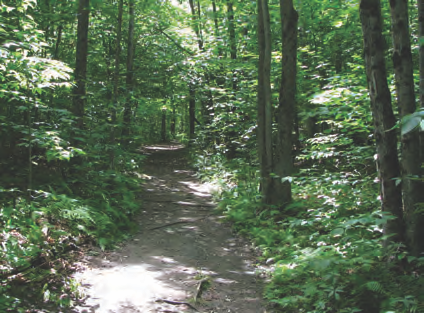Take Only Photographs, Leave Only Footprints
Published Jun 1st, 2017
 Along a Norwich trail.
Along a Norwich trail.
Norwich has many fantastic trails around town, where people can enjoy exercising, botanizing, wildlife watching, or simply walking in the woods. The Trails Committee does an excellent job of monitoring and maintaining all the public trails, and many land owners are very generous in allowing trails across their properties. Fellow trail users, trail workers, and land owners are greatly deserving of courtesies and respectful treatment from all of us. What follows is a list of reminders about important components of trail etiquette. If you do not agree with what we lay out as appropriate trail etiquette, please do not hesitate to come and share your ideas and concerns with us.
In a previous article, we mentioned the importance of controlling dogs on the trails. It is worth repeating how off-leash dogs can upset fellow trail users and wildlife. There are many people who are not comfortable being approached by dogs they do not know. There are also many people who would rather see un-spooked wildlife in the forest beside the trail instead of a dog running rampant.
Recent work on Green Up Day reminds many of us that not all our fellow citizens adhere to the adage ‘leave no trace.’ People especially do not want to see refuse, including dog droppings, during their walk in the woods. Please ‘leave only footprints.’
And leave those footprints only on the trail. The trails are constructed to handle foot traffic, the forest floor is not. If the trail is a single-track, use it as such. Please don’t walk in a group four wide if the trail cannot accommodate that width of humanity.
Further speaking of footprints, it is important that all posted trail instructions be followed, even if the instruction is that the trail is closed. Permitted uses, redirected trails, trail closures (for mud season for example), and other trail instructions are decisions made by people dedicated to the long-term care and maintenance of trails, people who spend time learning about best trail practices. Those instructions about and temporary closures of trails are done to alleviate the damage that too many footprints can have on fragile trailside areas and soft, wet trails.
Regarding trailside areas, remember to also ‘take only photographs.’ The plants within our trail corridors are part of natural communities and they have roles to play in their ecosystem. They are not there for a few of us to take, take, take. Collecting has already made wild ginsing very rare and cucumber root much less common. Let’s not add to the list of the over-harvested; let’s instead have all the plant species remain part of their ecosystem and be there for all to see.
Many of our trails are multi-use and these different ways of using trails can lead to some questions, the proper etiquette of which may be conditional. For example, on flat terrain it may well be appropriate for bikers to yield to walkers, whereas on steep terrain it may well be better for walkers to step aside for bikers; however, a biker should never expect a hiker to yield on a multi-use trail.
There can also be winter multi-use etiquette questions. If someone has gone to the effort of breaking trail and setting a ski track, be courteous by not obliterating their work with your snowshoes. Why not simply snowshoe beside the ski trail? Besides, snowshoes are designed to provide loft in unbroken snow, not tramp around on packed trails and ski tracks.
Well, mud season is a memory. Get out there, be courteous, and enjoy the trails!
Originally published in Summer 2017 Norwich Times